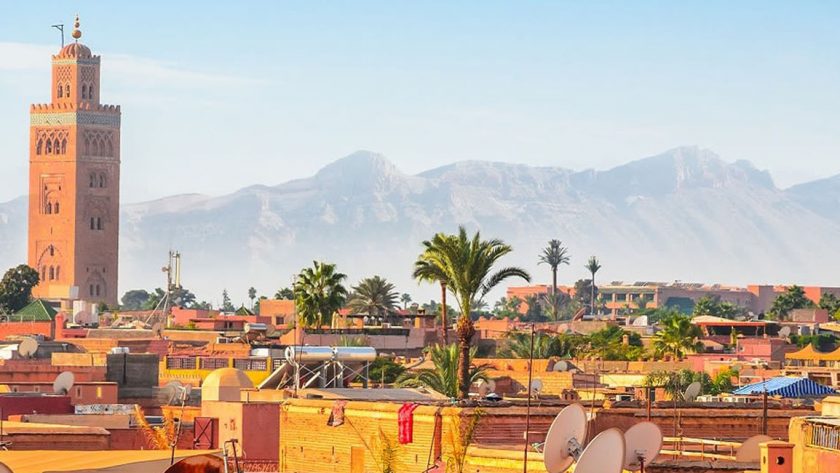IN BALI, IT’S BATIKS. In China, it’s just about everything (bootleg, of course). Souvenirs have tempted travelers to become importers since the heyday of the Silk Road, and in Morocco today, nothing has changed. In Marrakech, amid the snake charmers and boxing promoters, you’re bound to share a glass of mint tea with a backpacker who’s spent more than $1,000 on about five kilims – rugs – of varying shapes, sizes, colors, and fabrics, and who dreams of selling each for a grand on eBay.
In the rug trade, Morocco is like Turkey 30 years ago: a relatively young market where merchants are testing the price ceiling on carpets that are not only of good quality and design (geometric patterns abound) but also a rare curiosity back in the States. To get one, however, you’ll have to bargain. The average Moroccan salesman puts an American used car dealer to shame. A Fes carpet merchant, drawing on a millennium of salesmanship, could sell a herd of camels to an Eskimo. shop in a dusty, narrow back alley reminiscent of the Mos Eisely spaceport on Tattooine. Over mint tea, we talked about Eminem – his choice of subject, not mine – every day for a week. Only then did he offer to show me a rug. Once, I wandered into Chez El Moutaousset, a twostory carpet store hidden deep in Marrakech’s maze of souqs, along with a couple from Seattle who’d already bought three rugs but wanted to make sure they’d gotten a good deal. But that wasn’t enough for Mohamed Touareg, the proprietor.
“We’re just looking,” we explained.
“Of course. Come have a look,” Touareg said, leading us upstairs into an air-conditioned room with thousands of carpets piled on top of each other from floor to ceiling. We sat on a cozy sofa, and Touareg offered us mint tea. We said no, but his assistant brought some anyway. Then he shut the door. We laughed, but we were all a little frightened. Touareg was a fast talker, and we didn’t know what was going on. The assistant began them on the floor. The Seattleites admitted that Touareg’s carpets were nicer than those they’d bought in Tangier, but told him they had neither the funds to buy more nor the strength to carry home more than three.
But Touareg ignored them. He kept barking at his assistant to pull down more carpets. When they showed interest in a purple one, the assistant pulled down a dozen purples. Eventually, with a pile of 30 rugs on the floor, Touareg told the couple to have the assistant remove rugs they didn’t like, one by one, until they were left with two utterly beautiful pieces.
Then he gave us every line in the book: The rugs would pay for food for a year for some poor Berber family. The rugs were made of silk. They were decades old. They would retail in New York for thousands. Forty minutes after we walked in, we began to talk about price. The Seattle pair were still unsure; they discussed it, decided not to buy. As we were about to leave, Touareg lowered the price a good deal. The couple hesitated, but I casually mentioned that I might be interested in a rug myself. That was when Touareg agreed to let us have the three five-by-nine-foot carpets for $200 each – actually less than I was willing to spend – and when I said I needed to run out to an ATM, Touareg assured me he accepted all major credit cards.
WHAT KIND OF RUG IS THIS RUG?
Before you embark on a bargaining expedition, it’s not a bad idea to know what you’re bargaining for. There are two major types of rugs made in Morocco: The city (or Rabat) carpets, made commercially along the Atlantic coast, and tribal weavings. City rugs are low-quality, with inauthentic Turkish or Persian motifs that most international dealers say give Moroccan rugs a bad name. The tribal designs may be pile rugs dyed orange, white, or a bright pastel, but the flat weave is the most representative of Morocco and likely what you will be sold. Created by Berber tribes in the High and Middle Atlas mountains, on the plains of Marrakech, and elsewhere, most are made from wool, although silk is occasionally used, too. (Watch out for silk substitutes, like rayon.) Generally speaking, the High Atlas rugs tend to recall a Navajo rug with zigzag designs, while the Middle Atlas rugs tend to have a red base with geometric patterns. Of course, there are always exceptions.
The only thing worse than paying too much for a rug is paying too much for a fake rug. Unfortunately, there’s no easy way to determine authenticity. Some merchants claim a rug is authentic because it has tassels on just one end – which is just a typical feature. To determine if a rug is actually made of wool, you can put a flame to it (with the permission of the merchant, of course). Real wool will singe.
No matter what slick Rick the carpet sheikh tells you, there’s no objective scale for judging a rug’s worth. A $200 rug can be fabulous, a $2,000 one can be garbage. Most backpackers seem to be paying $200 to $350 for a five-by-nine – but artistry is probably the biggest factor. If it looks good to you, then it is good.
SPINNING WOOL INTO GOLD
Trying to get rich off a few Moroccan rugs is bound to end in disaster – just consider them good gifts for friends and maybe a way to earn a little back via eBay. A quick glance on an online auction site reveals that about half the rugs are being sold by backpackers.
One of these is David Turley, who did a loop around Morocco in August, his second visit to the country. He and two travel buddies anticipated finding rugs in Marrakech, but after failed negotiations, they left empty-handed. But on a visit to Essaouira, which is known more for woodworking and Jimi Hendrix than for rugs, they were able to get a good deal from a small, not-so-touristy shop.
“We started off bargaining for one rug and then kept adding more and more rugs to the deal,” he told me. “Four we’re keeping – three we’ll try to sell. We checked out consignment – too expensive – and saw eBay as the best market. The competition will make it tough, but I don’t think there’s any reason we can’t double our money . . . even if it takes a couple exposures on eBay to move them.”
Myself, I decided not to become an amateur importer. After all, I’ve lost money in every way imaginable – e.g., paying a snake charmer ten bucks to let him rub a snake on me for good luck. I just stuck to my one magic carpet, which even when rolled up tight took every inch of extra space in my pack. When I got home, however, I was surprised at the interest it drew from friends and family. Several people offered me two to three times what I paid for it. At first, I was tempted to part with it, but you know what? It really holds the room together.



